A few hours after landing in Vientiane, I attended an exhibition called Turning Points at Ban Naxay Gallery that featured the work of three Lao artists. There was some tension in the air that night. I learned from one of the artists that because of the nontraditional aspects and themes of the work, there were fears that the government might not let the show happen. One of the artists started talking to me about an artwork he had made last year that spoke out against deforestation in Laos. He quickly covered his mouth, looked around and said, “Shh, we can’t talk about that stuff here.” I knew immediately that these were the kind of artists I wanted to work with. One of the artists in the show would eventually be a small grant recipient for the Laos Arts Incubator, while another would become my translator and project manager.
I spent my first few days driving the city on my motorbike and getting oriented. I noticed immediately that not only was there very little street art, there were hardly any public murals at all. I came to learn later that there weren’t any contemporary public murals painted by Lao artists in the entire city. While the temples are filled with incredible murals and some private businesses have smaller ones, a mural on a truly public wall didn’t exist. I originally planned to teach a workshop that explored alternative street art techniques like reverse graffiti & hydrophobic stenciling; however, I realized that the most radical thing we could do in Laos would be to design and paint a mural in public for everyone to see.
In the U.S., young artists are encouraged to express themselves freely. It is common practice for teachers and mentors to push students to break rules and create new ones in the name of moving into uncharted territory with the work. Artists in Laos are expected to stay within the narrow confines of the art traditions deemed acceptable by their teachers. While the painting students here have mastered the formulaic structure of traditional landscape painting, portraiture and the still life. However, without that nudge to expand the work into fresh visual terrain, much of the artwork remains static. What is left is a generation of technically gifted artists who are hungry to say something new with their work.
“What can we make in twenty five days?” This is what I asked the artists at the Laos Art Incubator introduction lecture. What took place next was a citywide collaboration of over one hundred local artists and community members who brought their talent, passion and energy together to create something powerful and beautiful. Through visual art, performance and community-based activism, the projects engaged the imagination of children and adults alike as we brought attention some of the most important environmental issues impacting local communities today.
After the small grants were awarded each group had three weeks to take their proposals and bring them to life. The projects evolved organically, each one taking twists and turns along the way.
Toh Tokabonglao and his Khao Niew Lao puppet group spent much of their time at the Dong Paleap Library outside of the city center. The library is a safe place where children from poor families can come and play and make arts and crafts. Toh and his team held a four-day workshop with fifteen children where they discussed the importance of recycling. They walked around the neighborhood collecting discarded plastic bottles and other reusable waste. Under the guidance of Khao Niew Lao the children cut, glued and strapped the plastic together in creative ways to make snakes, pigs, and other animals that they would eventually turn into puppets. The last part of the workshop was spent rehearsing the puppet show that they would perform together at the exhibition the following week.
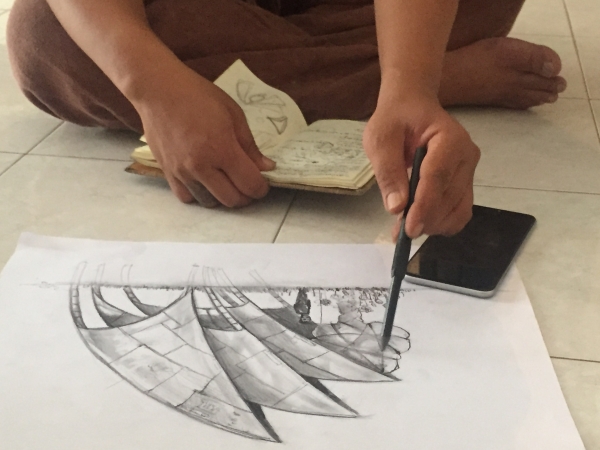
Meanwhile on the other side of Vientiane,
Bounpaul Photyzan was busy designing and constructing Plastic City with his students from the National Institute of Laos Fine Arts. The installation went through several design phases as he experimented with materials and various structural plans. Bounpaul and his team often worked into the early hours of the morning painting and constructing the piece. Several times throughout the project the team had to seek shelter from rainstorms that swept over the city with no warning.
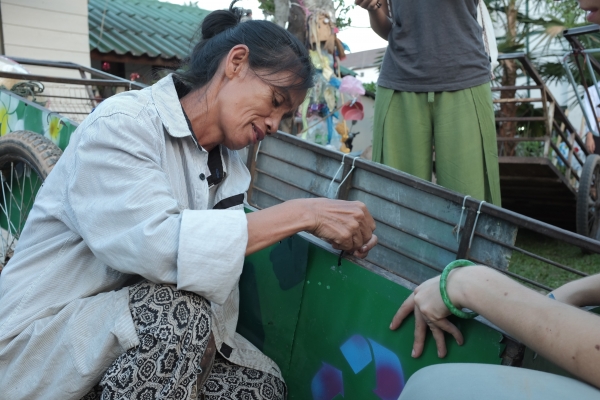
The goal of Green Vientiane’s Recycle Khoi (Recycle Me) cart project was to celebrate the men and women that collect discarded plastic and other recyclable waste by decorating the carts they push around the city. Their team interviewed the cart owners and had artists create personalized designs for each cart. By placing a spotlight on the trash collectors themselves, the beautified carts encourage people make the connection between the waste they create and what happens to it after it has been thrown away.
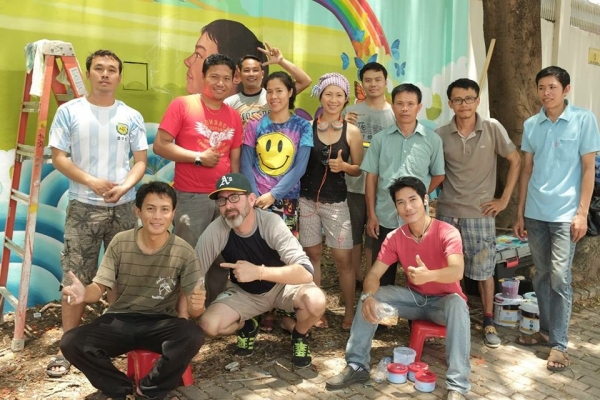
I concentrated my efforts on working with the Color of Future Mural Collective to paint the sixty-foot mural on the wall outside of the old U.S. Embassy. Once we broke ground we had less than two weeks to complete it, and were faced with the harshest season of the weather as temperatures reached one hundred degrees during the day with big rain storms looming every night. During the first few days of the project we invited children from the community to come help paint. The mural site is on a busy road in the middle of the city and parents would actually drive up on their motorbikes and their kids would hop off and start painting. We saw lots of big smiles and colorful messes during those days. The professionals took over after that and clocked twelve-hour days in the heat to finish the mural. Excitement grew as the image became more intricate and refined with each passing day. I have been painting murals for twenty years and this is one of the most talented groups of artists that I have ever worked with. We completed the mural a day before the exhibition. The sense of pride and accomplishment was tangible as we wrote each artist’s name on the wall next to the mural. The Color of Future Mural Collective logo is stamped next to the names along with a phone number, as they are officially open for business.
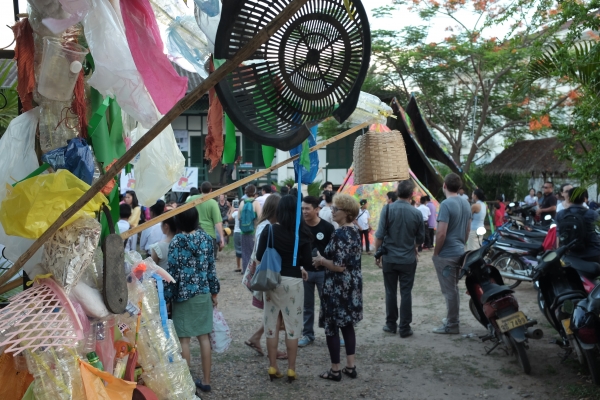
With the ever-present present threat of a big rainstorm, everyone was cautiously optimistic as we prepared for the final exhibition. A big storm ripped through the city the night before, however, there was magic in the air that evening as the clouds parted and blessed the event with clear skies. Ban Naxay Gallery was a fitting site for the festivities as this was my first stop upon my arrival in Vientiane almost one month ago. Over one hundred people from the Vientiane community attended the event! Green Vientiane made their final preparations for the carts on site and even enlisted the assistance of the students from the National Institute of Laos Fine Arts. Children, families and artists gathered in anticipation for the Khao Niew Lao performance with the children from Dong Palaep Library. They watched in awe as the recycled plastic puppets came to life before their eyes and delivered a powerful message about the importance of taking care of the environment. The sun had set as the performance came to an end and Plastic City lit up the courtyard. The architectural sails of the piece engulfed a neon plastic garden of trees and flowers and filled the courtyard with an otherworldly glow. Children and adults danced in and around the structure late into the night, smiling, laughing and posing for pictures. While the celebration marked the end of the Laos Arts Incubator, seeds of change have been planted amongst the artists, the children and the community in this vibrant riverside city.
Where are they now?
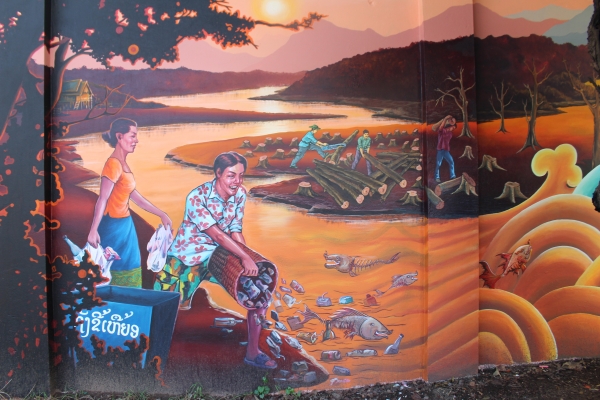
The Color of Future Mural Collective is currently designing its second mural to be painted on the front of the new campus of the National Institute of Laos Fine Arts. They will begin painting next month.
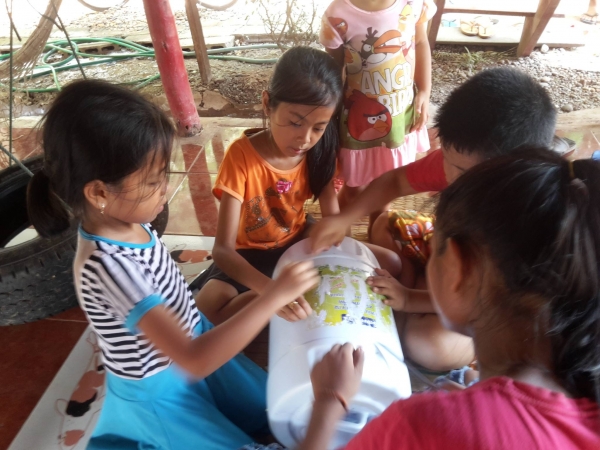
Khao Niew Lao will use the elements from their collaboration with the children as the foundation for a new performance to be shown at an International Performance Festival held in Vientiane in January ’16.
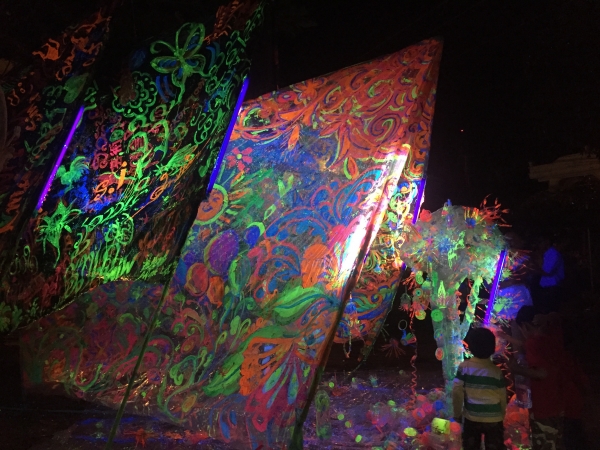 Bounpaul Phothyzan
Bounpaul Phothyzan
is currently in discussions with local institutions to find a permanent home for Plastic City.
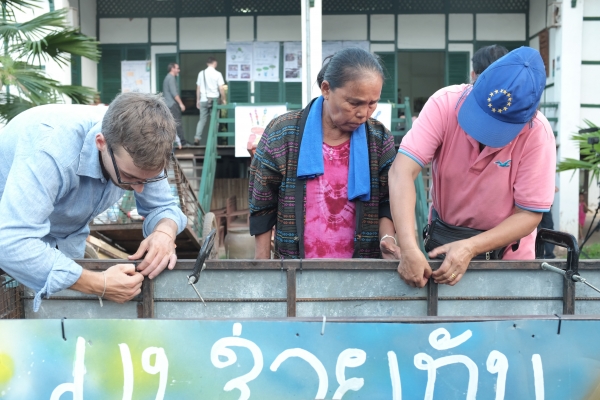
Green Vientiane is planning a citywide Adopt-a-Cart initiative in Vientiane where local schools and businesses can sponsor the decoration of recycling carts around the city.
[et_pb_section fb_built="1" admin_label="section" _builder_version="3.19.6" custom_margin="0px||" custom_padding="0px||"][et_pb_row admin_label="row" _builder_version="3.19.6" background_size="initial" background_position="top_left" background_repeat="repeat" custom_margin="||" custom_padding="||"][et_pb_column type="4_4" _builder_version="3.0.47" parallax="off" parallax_method="on"][et_pb_text admin_label="Text" _builder_version="3.0.74" background_size="initial" background_position="top_left" background_repeat="repeat"]
We have awarded the third round of the American Arts Incubator “small grants” to local Lao artists and organizations. The public presentation of the projects was hosted by i:cat Gallery and was attended by over thirty local artists, leaders, and curious members of the community. I unveiled the mural design created during the workshop that had been submitted to the Laos Government for approval. Just at that moment, Matthew Ference, the Public Affairs Officer at the U.S. Embassy announced he had received an email from the Laos government approving the mural project. The room erupted in cheers and smiles.
The first small grant was awarded to the Khao Niew Lao ("Sticky Rice") Theater Group. Insisiengmai Lattanakone (Toh), is the director of this Lao performance group that uses found materials to create beautiful puppets and props. Toh will create three puppets for a performance that promotes reusing and recycling plastic waste. Each puppet will be constructed of recycled plastic purchased from the local collectors who walk around the city and pick up the trash. The puppets will be a visual representation of the amount of plastic waste produced by the average household in Laos in one day, one week, and one month. Toh also will travel to a children’s center outside the city to hold a workshop on the importance of reusing and recycling plastic. The young workshop participants will create small sculptures out of plastic that they collect around the neighborhood; the work they produce will be installed at the public exhibition as part of his performance. By empowering youth to learn sustainability through art-making and collaboration, this project hopes to begin a new tradition of innovative environmental health practices that is interactive and fun. The concept for this project will serve as the foundation for a larger performance at the international puppet fair held next January in Vientiane.
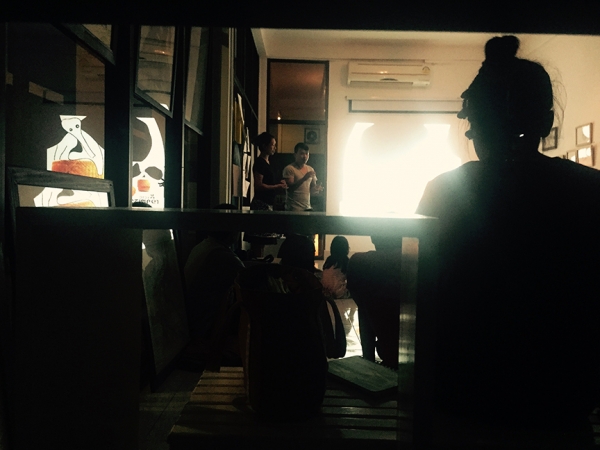
The second grant was awarded to Bounpaul Phothyzan, a professor at the National Institute of Fine Arts. Bounpaul will produce a large-scale public installation titled “Plastic City” that will be made out of trash and discarded materials. The structure for the installation symbolizes the wave of new architecture being rapidly constructed around the city. This obsession with the “new” here in Laos is part of what causes people to think only about short-term benefits of development, or the convenience of plastic. He will collaborate with students from the National Institute of Fine Arts to construct his project. The work will be temporarily installed for the public exhibition where it will become one of the first contemporary public art installations in the country. The vision is to find a permanent home to install the piece after the exhibition.
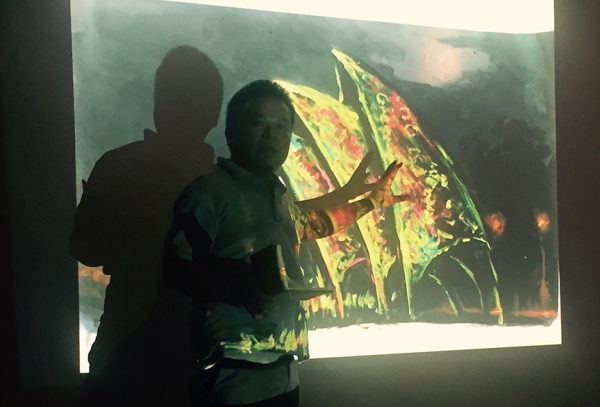
The third grant will go to Green Vientiane, a local organization that works to keep the city of Vientiane beautiful by promoting healthy recycling habits and encouraging local communities to reduce waste. Only about 40% of waste in Laos ends up in landfills or gets recycled. The remaining garbage gets burned, thrown on the ground, or dumped into the Mekong River. Trash collectors push primitive carts around the city and collect plastic and other materials that can be sold to the recycling center. These people are virtually invisible as they move through the city and clean up the trash. Green Vientiane’s project is titled, “Make My Cart Beautiful,” which will pair local artists with cart pushers to design and paint their carts. The artists will customize their design to interests of each cart pusher. The newly painted carts will help make the work that these people do every day more visible. The long-term vision is to start an “adopt a cart” program where local businesses, schools and organizations can sponsor the beautification of a cart.
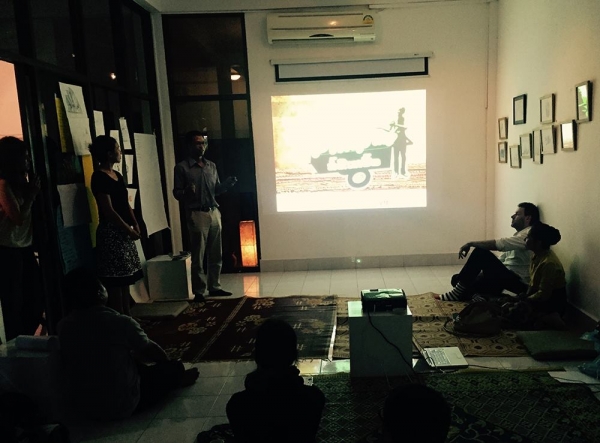
The final grant was awarded to the newly-established mural collective, Color of Future, made up of twenty professors and students from the National Institute of Laos Fine Arts. Two professors shared their experiences during the workshop and talked about their vision to take the knowledge that they will acquire this month and share with their students to launch future projects. The next two weeks will be their research phase as they continue to learn each step of creating a large-scale mural with me. After this project, they plan to create a mural to be painted on the front of the new campus being built at the National Institute of Fine Arts. They will engage the students in the process, and teach them the skills they have learned from the workshop. Eventually they would like the students to design and paint their own murals as part of a new permanent curriculum at the school.
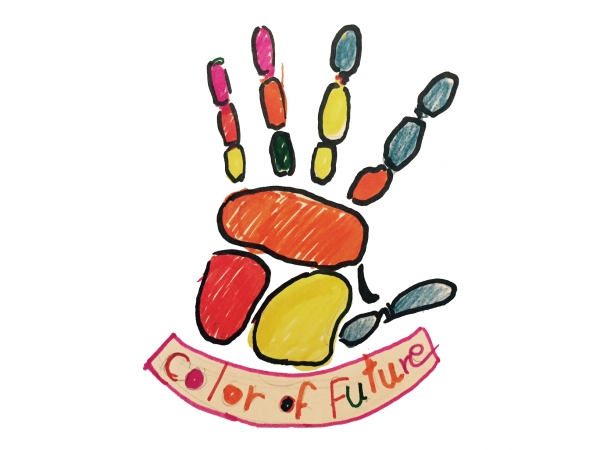
[/et_pb_text][/et_pb_column][/et_pb_row][/et_pb_section]
[et_pb_section fb_built="1" admin_label="section" _builder_version="3.19.6" custom_margin="0px||" custom_padding="0px||"][et_pb_row admin_label="row" _builder_version="3.0.48" background_size="initial" background_position="top_left" background_repeat="repeat"][et_pb_column type="4_4" _builder_version="3.0.47" parallax="off" parallax_method="on"][et_pb_text admin_label="Text" _builder_version="3.0.74" background_size="initial" background_position="top_left" background_repeat="repeat"]
I arrived in Laos with three rules for myself; stay open, ask questions, and listen.
Once people started talking, the same issue kept coming up: the accumulation of trash around the city. Laos is a developing country that is in the throes of robust economic and urban development. The growth in and around the city is outpacing the existing infrastructure to manage the amount of waste being produced on a daily basis.
The city produces at least 637 tons of waste per day on average. Only 250 tons of waste is recycled or taken to landfill, according to the United Nations Environment Programme. This leaves almost 400 tons of waste per day that either ends up being burned or tossed in the streets, canals and rivers. Mass amounts of plastic only started being used in Laos about twenty years ago, so it is a relatively new product in terms of widespread use. Traditionally, food items were wrapped in banana leaves and other organic materials. These items could be thrown on the ground and they would decompose or used in fires without any environmental consequences. Today, the banana leaves have been replaced by plastic bags and bottles; they are discarded without regard to where they will end up, and burnt without considering the impact of the air. That toxic scent of melting plastic is common around the city.
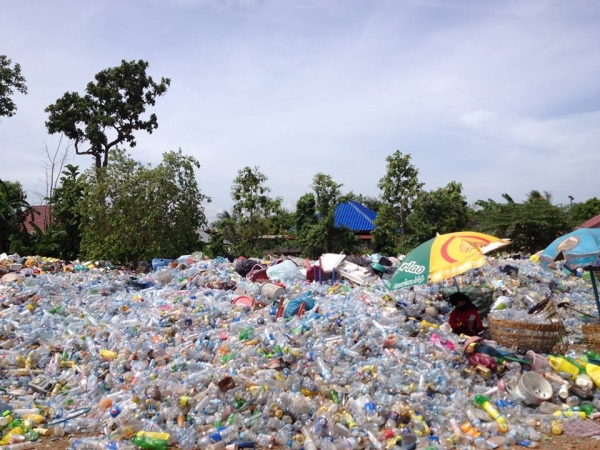
There are trash collectors who push wooden or metal carts around the city, collect plastic and other recyclables, and bring them to a local recycling center in exchange for money. The price for plastic, however, is directly impacted by the price of oil. In the US, we celebrate when gas prices drop. In Laos when the price of oil drops, the demand for recycled plastic also drops because it is just as cheap to purchase new plastic. The trash collectors end up receiving less money for the plastic that they collect and have less incentive to gather it.
The work ahead of us all -- as artists, students, teachers and youths -- presents a grand responsibility and vital opportunity to use public arts as a way to help influence public practices regarding environmental health. As we continue the collaborative process of mural-making to educate neighborhoods about practices like recycling, each community can work together to build a better environment for the future.
[/et_pb_text][/et_pb_column][/et_pb_row][/et_pb_section]
I have been in Vientiane for seven days. These days were packed with workshops and meetings with Lao artists, and youth and environmental groups where we made art, shared our dreams, and discussed ways to improve the environment.
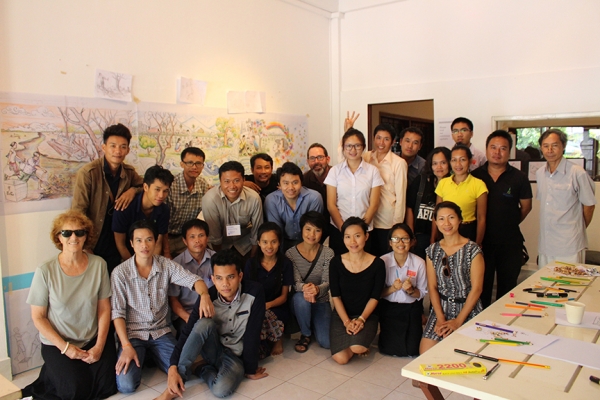
This city is virtually devoid of public art.
The few murals that do exist are either propaganda for the Lao PDR Government or small murals painted by foreigners who work with a private business. In Oakland where I live, we are in the midst of a street art renaissance where new murals are popping up almost on a weekly basis. It’s a beautiful thing. Here in Laos, there is virtually nothing. The idea of creating a painting to be displayed in public outside of a gallery or museum is hard for local artists to fathom. Established artists use assistants as cheap labor here all of the time, but the act of artists working collaboratively to produce an artwork that honors the voices and skills of each artist is also very new.
Twenty professors and students from the National Institute of Fine Arts showed up for the workshops each day this week, during which I walked them through each step of creating a collaborative mural. Under my guidance, this group created the concept, developed sketches, and produced a fully realized design in only three days! They will spend the next two weeks painting the mural together on a public wall in the middle of the city.
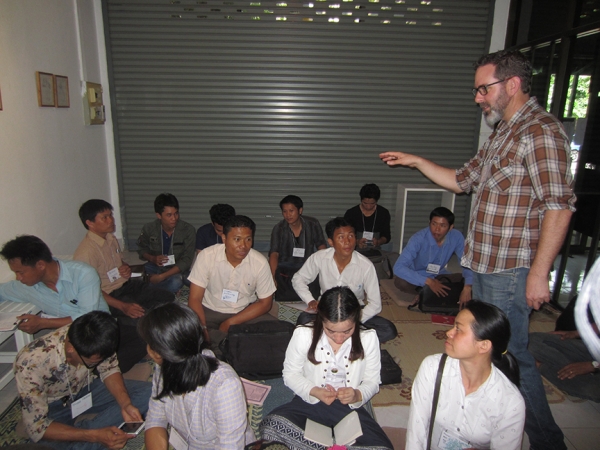
During the workshop, we discussed the environment and the issues that most concerned the Lao people. The artists started by creating their own individual drawings that illustrated the issue that resonated with them the most. We placed the drawings on the wall and began to talk about the similarities between the images and the ideas. The accumulation of trash and plastic around the city was recurring theme in many of the drawings. Some of the artists illustrated the problem of people dumping trash into the river while others offered solutions with images of people picking up trash and planting trees. A few artists dreamed about what the future might look like if everyone worked together to help change the habits of the people and make the environment more of a priority. This became our concept for the mural: identify the problem, illustrate the solutions, and show the dream for the future. We had our idea.
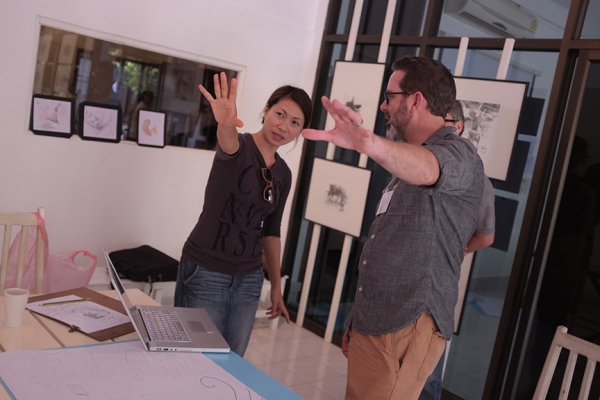
The artists broke into teams to create the scenes of the mural. In less than eight hours over two days the artists worked together to create a ten-foot full color sketch of what the mural would look like – keeping in mind that Lao artists do not normally collaborate together like this. The teaching and the art practice here is very formal and traditional. All artists are gifted in the technical aspects of drawing and design, but are not encouraged to expand beyond traditional formats.
The energy and excitement increased with each day as they worked toward finishing the design. It was like watching a dance where one artist would begin drawing a figure, another would step in and add the detail, and another would twirl in to add the splashes color.
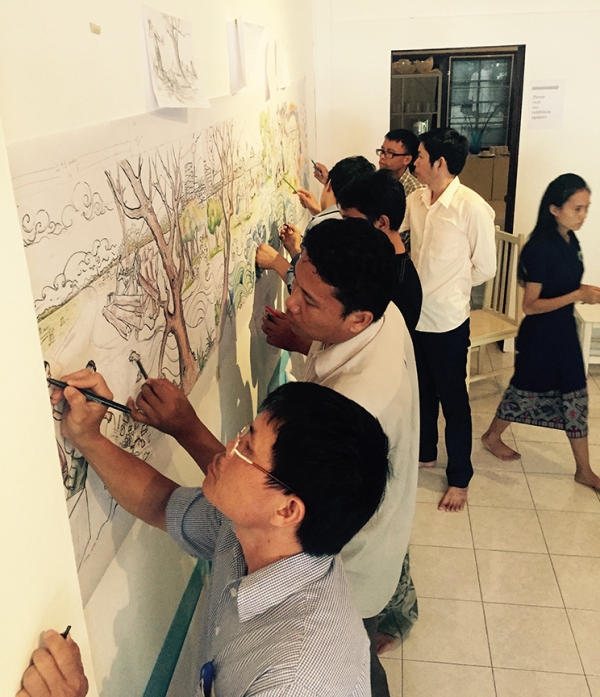
On the final day, the artists at the workshop formed a mural collective with the vision to start a mural program at National Institute of Laos Fine Arts. We brainstormed names and had a logo design contest to vote on our favorite ideas. The mural collective, “Color of Future,” was born. By venturing into uncharted public arts strategies and breaking from traditional arts practices, this collaborative group of Lao youth and professors will soon unveil a creative resolution to raising awareness about environmental issues and plastics to carry outwards to their communities, elders, and future generations. They will spend the next two weeks painting the mural on a public wall in the middle of the city.
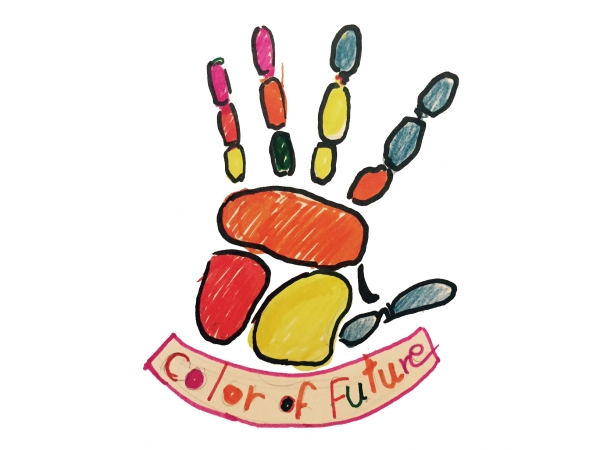
The intensity of the heat engulfed me as I stepped out of the plane and onto the tarmac at Wattay International Airport in Vientiane. It was both arresting and comforting, reminding me of the hot summer days during my last trip to Laos almost four years ago. After spending the night under the bright lights and bustling atmosphere at the Bangkok airport, Vientiane was sleepy and quiet by comparison. My large boxes of paint and supplies were waiting for me inside the airport and I was relieved to be waived through customs with nothing more than a nod. After months of preparation and anticipation, I had finally arrived.
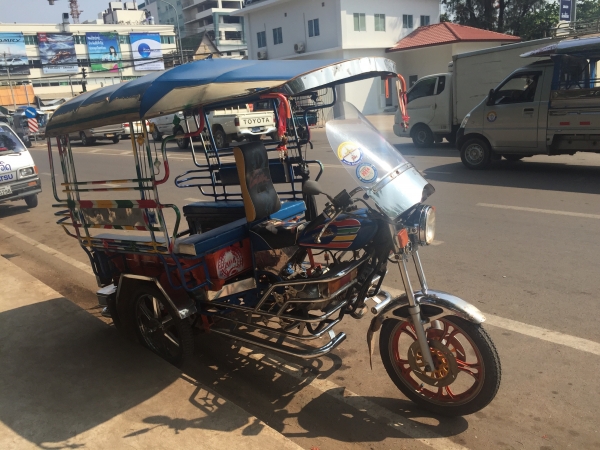
On my first night here I had the chance to attend an exhibition of young Lao artists who are breaking out of the traditional Lao art practices.
It is easy to forget how fortunate we are to have the freedom to express ourselves creatively in the US. That freedom does not exist in the same way here in Laos as there are very rigid parameters for what contemporary art should look like. It was only my first night, but already I could feel the energy around the younger artists eager to push contemporary art in Laos into new territory. It was exciting and encouraging to meet these artists.
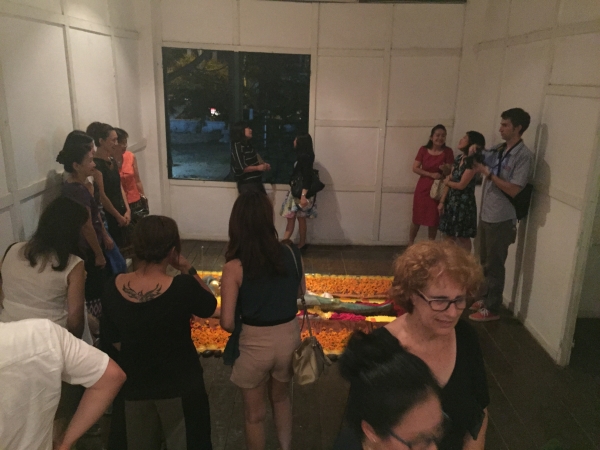
That night, I was awoken by the drums from the neighboring temple. The drumbeats were soft and persistent, a subtle reminder of rich history and religious traditions that are such an important part of Laos culture.
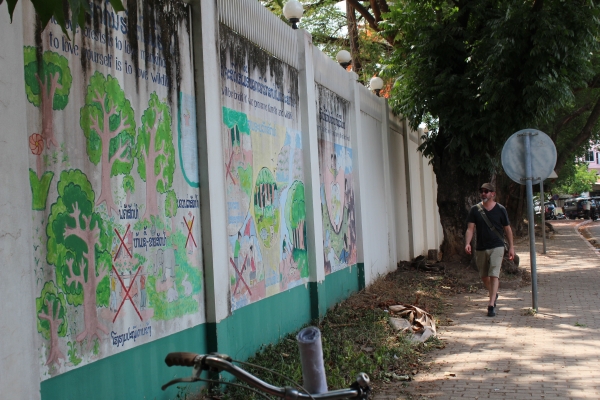
Tomorrow night we officially kick off the Laos Arts Incubator project with an artist talk and lecture titled: Public Art and the Collective Conscience.
It will be a chance for interested artists and groups to learn more about the project, ask questions, and hopefully be inspired enough to return for the workshops during the rest of the week. So excited to finally be here! More to come...
The American Arts Incubator kicked off at the ZERO1 Garage in San Jose, California this past week. After over a year of planning, the excitement in the room was palpable as the four participating artists gathered for the first time with the ZERO1 staff and a U.S. State Department Representative to discuss the details of the project. We talked at length about the challenges and opportunities that the artists will face in each of the countries that we will be visiting: Mongolia, Papua New Guinea, Laos and the Philippines.
We tackled some big questions. How do we come alongside local artists and community members in each city and empower them through a communal exchange of ideas and artistic expressions that is not only impactful but also sustainable beyond our visit? How do we leave enough room in our plans to allow unexpected ideas, voices and circumstances influence the outcome of our project while still honoring the overall intent of the program? Innovative ideas and strategies came to light through numerous brainstorming sessions and roundtable discussions. The ZERO1 staff is incredibly talented and is deeply committed to supporting the artists and setting us up for success by helping shape the vision for each of our projects.
After years of leading community based murals projects in the States, I look forward to the unique challenges of working in Laos. I was truly inspired by all of the participants at this three-day orientation. I left feeling motivated to push myself to reconsider what a mural can be and how it can function in a society whose perspective and relationship to public art is vastly different from our own. Stay tuned as our projects continue to evolve and take shape!
[et_pb_section fb_built="1" admin_label="section" _builder_version="3.19.6" custom_margin="0px||" custom_padding="0px||"][et_pb_row admin_label="row" _builder_version="3.0.48" background_size="initial" background_position="top_left" background_repeat="repeat"][et_pb_column type="4_4" _builder_version="3.0.47" parallax="off" parallax_method="on"][et_pb_text admin_label="Text" _builder_version="3.0.74" background_size="initial" background_position="top_left" background_repeat="repeat"]
Environmental protection has been something I have been addressing in my work for the last five years. As we continue discussions with the U.S. Embassy in Laos, one of the issues I’ve come upon in my research that interests me is deforestation.
In 2009, I spent eighteen months teaching at Chiang Mai University in Northern Thailand. I was initially struck by the beauty of the sweeping rice fields, the lush vegetation and the overall beauty of the countryside. Over the course of the year I began to notice numerous construction and development projects consuming much of the open space in and around the outskirts of Chiang Mai. In a city that already suffers from dangerously high pollution rates during the summer, this growth and expansion places more strain on an already strained microclimate. Unsustainable farming regulations implemented by the government puts rural communities who depend on crops for survival at risk as land becomes unusable over time.
Early research of some of the top environmental issues in Laos revealed circumstances similar to what I witnessed in Thailand. Robust economic growth has created conflict between foreign investors and the loose government regulations that control the extraction of the rich surplus of natural resources in Laos. Villagers have lost land to foreign investment projects, which has led to more people moving to cities. This increased urbanization places pressure on natural resources and creates new environmental problems in urban centers. Illegal deforestation and mineral extraction are two main concerns as foreign agencies easily exploit loopholes and blind spots in the system.
As I work to identify the main challenges that the country faces, I am also discovering many groups and agencies doing wonderful work to help protect natural resources and the communities most affected by these issues. I hope to find more first-hand accounts from Lao people who are being impacted by all of this change. All of this will help inform the imagery and themes that will eventually become the foundation of the mural itself.
UN Development Program - Lao PDR:
http://www.unpei.org/sites/default/files/dmdocuments/PEI%20brief%2008_2010_Mining_english_d.pdf
http://www.unpei.org/what-we-do/pei-countries/lao-pdr
[/et_pb_text][/et_pb_column][/et_pb_row][/et_pb_section]